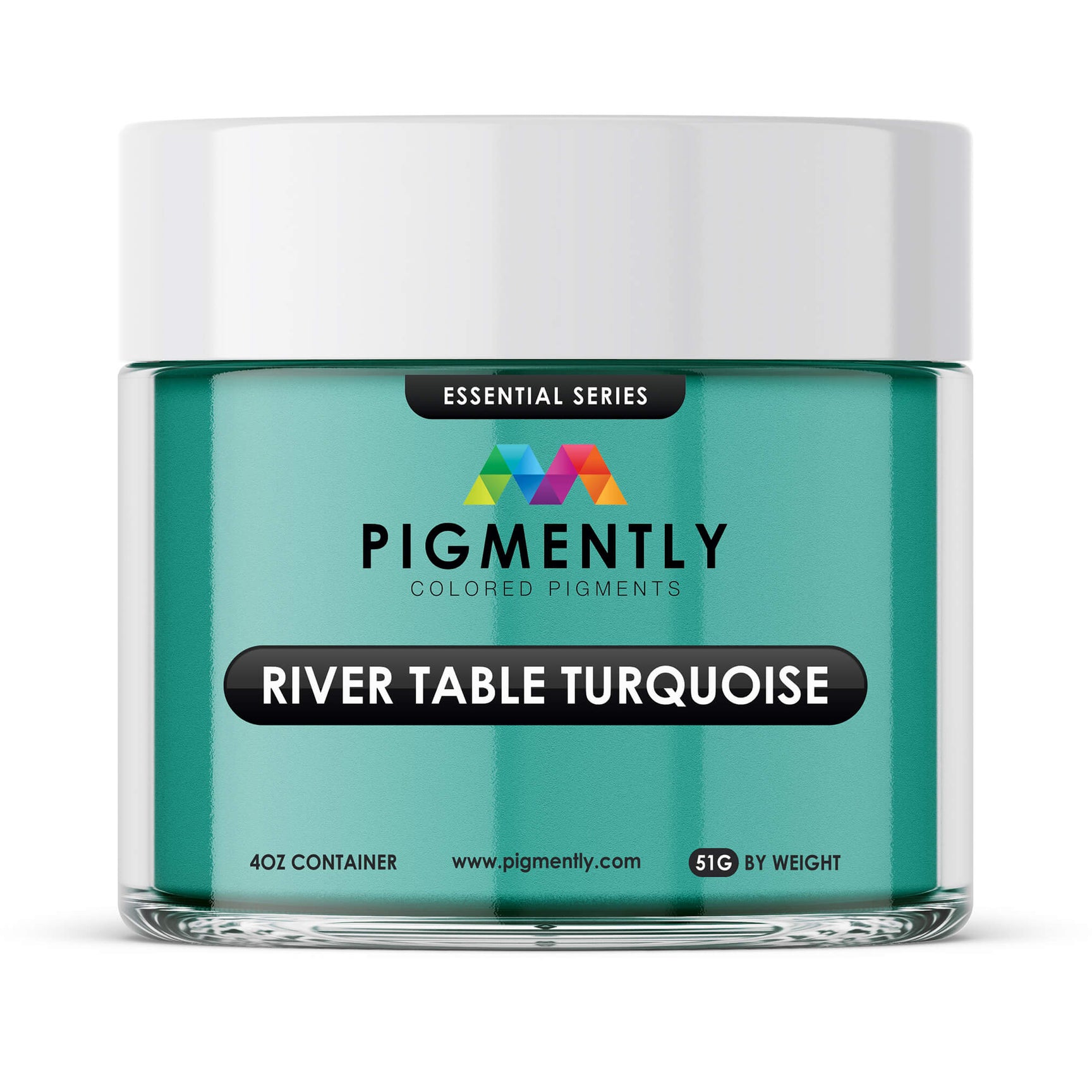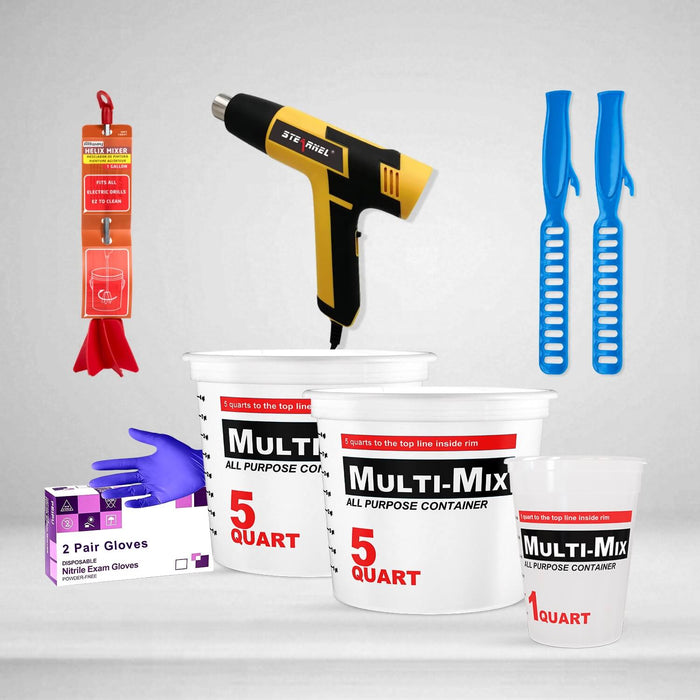Welcome to our guide to sanding epoxy resin.
If you're unfamiliar with epoxy sanding methods, this guide will help you understand what you need and how to do it without making a big mess.
What is sanding for?
Sanding is a technique used to smooth out the rough surfaces you may end up with when working with epoxy.
In some cases it's a necessary part of the project. Other times, you may need to repair some damage, and sanding can help do that. And sometimes you just make a mistake during the resin process and want to fix it after it cures.
For people willing to go the extra mile, it's usually a precursory step to polishing epoxy resin.
How difficult is it to sand epoxy?
There's no way around it. While sanding epoxy resin isn't particularly hard or complex, it is a time-consuming process—The larger the project, the longer it will take. This is because epoxy resin is both smooth and very strong at a microscopic level. This is especially the case with our UltraClear Table Top Epoxy, which has a Shore-D hardness rating of 98 out of 100.
Fortunately, the time it takes can be lessened by using certain tools, which we'll explain later.
If you have a goal and are willing to put in the time it takes to reach it, you'll probably be more than satisfied with your end result.
Nonetheless, it's important that you can set aside a significant amount of time. It doesn't need to be done all at once.
Needless to say, your epoxy needs to be fully cured before you do any heavy sanding. Since you won't be working with a live batch of resin, you have the option to work on your sanding a little here and there as your schedule permits.
Before we dive in, some things about sanding to be aware of:
Your project's size and shape determine what tools and supplies you'll use.
In some ways, this makes slightly larger projects easier than tiny projects like resin jewelry or charms, because common big power tools can reduce the manual labor aspect of the process.
Sanding creates unhealthy dust. You can prevent it.
You absolutely don't want to be breathing in the sanding dust, and there are several ways to mitigate this concern:
- Wear an N95 or KN95 respirator.
- Use wet sanding during the fine-grit steps.
- For medium/large projects, choose power tools that support dust bags or dust extractors.
By using these solutions, you can make this concern trivial.
Two methods: Dry sanding and wet sanding.
There are two styles of sanding: Wet sanding and dry sanding.
Dry sanding is when the surface you're sanding is completely dry. This makes it easier to whittle away rough surface imperfections. However, doing this also creates a lot of dust that can get dispersed into the air. We'll talk more about how to vastly reduce the dust a bit later.
Wet sanding is when the surface you're sanding is moistened first. Since epoxy is waterproof, this allows the dust to be "collected" by the water and absorbed into the sanding material. The upside is much less dust, and the downside is that some sanding materials will clog more quickly.
Many tool brands now create wet/dry abrasives that reduce clogging while still collecting much of the dust before it can be kicked up into the air.
For large projects, we use a mix of dry sanding and wet sanding with a random orbital sander.

How to sand epoxy resin
Step #1: Gather the tools and supplies you'll need.
We begin by gathering what you need to complete the project efficiently and safely.
-
A random orbital sander: This is a sanding power tool that uses circular motions to grind down uneven surfaces.
We use this instead of other sander types because it's easier to use and you're less likely to make mistakes with it.
It's a very accessible type of sander, useful for beginners and professionals alike.
Typical sizes include 5-inch and 6-inch. Either can work, so choose what seems better for the size of your project.
Note: Choose a sander that supports dust bags and/or dust extractors, as well as hook-and-loop sanding discs. Some brands make an attachment that enables use of hook-and-loop discs for incompatible sanders. -
Hook-and-loop sanding discs: These are what you'll attach to your sander. There are many brands, and they're mostly interchangeable.
What you need is determined by how rough your resin surface is. If the surface is very rough or deeply scratched, such as an epoxy piece that's been cut with a router, you'll want the following disc types: 120-grit, 180-grit, 240-grit, 400-grit, 800-grit, and 1200-grit.
However, if your goal is to sand a lightly scratched epoxy surface, e.g., an epoxy countertop, you can probably get by with just 400-grit, 800-grit, and 1200-grit.
The number you need of each varies based on project size and disc-type. Most hook-and-loop discs are reusable and can be washed.
Eventually though, they'll become too clogged to clean properly, and you'll replace them with a fresh disc of the same type to complete your sanding passes.
For a medium project (about 3 to 4 sq. ft.) 1 or 2 of each might do it. Make sure you have more for a bigger project. Sanding is not time sensitive, so worst case scenario, you can just go buy more if you run out. - N95 or KN95 respirators: These are for safety, as epoxy dust is unhealthy. We'll do what we can to prevent dust kick-up, but it's best to be prepared. Wear these when working with epoxy resin.
- A spray bottle (filled with water): Yep. Just a spray bottle of water. You'll use this to mist the surface when it's time to wet sand.
- Some microfiber cloths: These are for wiping down the surface after each sanding pass. It's a great way to remove residual dust without making a mess.
-
A compatible dust extractor or dust bags: A dust extractor uses air suction to pull dust into a contained receptacle. They're effective, but have to be purchased separately.
If you can afford one, and you think you'll use it again, we recommend it. They're quite handy. Otherwise, you can attach a dust bag to your sander to catch most of it. - A permanent marker (black ink, generally): You'll use this as a way to measure your sanding progress. It lets you know if you're missing spots, usually due to insufficient pressure or moving too quickly.
Step #2: Prepare your workspace.
Next, you'll setup your work area.
Place everything you'll be using in a convenient location where it's easy to reach but won't get in the way of your movements.
Make sure your sander has a dust bag or extractor hose attached.
You'll want to keep the cleaning cloths at hand because you'll be wiping the surface you sand after each pass.

Step #3: Sand your epoxy resin with coarse grit discs.
It's time to start sanding.
Be sure to wear your respirator during this part. And remember—this is a time consuming process, even a small section of resin can take up to an hour.
We'll do several passes over the sanding area with each grit, starting with the lowest, and using the "Right-to-left, top-to-bottom" technique.
What is the "Right-to-left, top-to-bottom" technique?
This technique involves slowly moving the sander in one direction, then lowering it a bit and returning. Each line will overlap the previous about halfway, which ensures full coverage while smoothing out your surface.
You'll move about 1 inch every 1.5 to 2 seconds while over the epoxy, since it is incredibly tough and takes extra time to sand away.
After each pass, you'll alternate, switching from horizontal lines to vertical lines. This helps remove scratching more effectively. Horizontal pass, vertical pass, horizontal, vertical, etc.
If part of your surface is exposed wood (e.g., a river table with partial resin coverage), you'll move a little faster across it, as wood can be sanded more easily, and you don't want to overdo it there.
Note: If you're just trying to sand out some light scratching, you may be able to skip to the 400-grit section.
-
We'll start with the 120-grit. Attach it to your sander, and begin at the top-right corner. Use the "right-to-left, top-to-bottom" technique described above.
Note: If your surface is a mix of epoxy and uncoated wood, you still need to pass over the entire surface to make sure you don't end up with a slump where the epoxy is.
After each pass, wipe the surface with your microfiber cloth to pick up some of the dust.
Note: Take a look at your sanding disc regularly. If it's getting clogged, clean it or swap it out, then resume. -
Wipe down the surface again if you haven't, then check to see if the more severe scratches have been sanded away.
If some are still there, you may need to do an additional pass. If they've been replaced by the lighter scratches of your 120-grit, then you're ready to move to the next grit. -
Next up is the 180-grit. This time, you'll need your marker and spray bottle, too.
Use your marker to make some lines in a wide zigzag pattern on your epoxy surface (but not on exposed wood, if there is any). You don't need a lot; these are just for measuring sanding progress. The sander will grind them away as you make your pass.
Once you've set that up, do 5 more passes, this time with the 180-grit discs. Continue with the "right-to-left, top-to-bottom" technique.
After each pass, the ink lines should be gone, so lightly spray the surface and wipe it down dry with a cloth to pick up the dust, then add new ink lines. Repeat this until you've done all 5 passes.
Keep an eye on your sanding disc, too. Don't let it clog.
After your 5 passes, take a look at the surface. The scratches from the 120-grit should be gone, replaced by lighter scratches from the 180-grit. If not, do an additional pass and reassess. -
Now we move on to the 240-grit. This phase is the same as the 180-grit.
Spray, wipe, add new ink lines, repeat. 5 passes total.
This concludes the course grit section of the guide. You'll start using the finer grits next.

Step #4: Sand your epoxy resin with fine grit.
If you're at this step, it means you've already finished with the coarse grit sanding. Or you didn't need it because your surface was only lightly scratched.
Either way, it's time to sand using fine-grits.
These include the 400-grit, 800-grit, and 1200-grit.
- Wipe up your surface, then use your marker to add wide zigzag lines onto your epoxy surface. You don't need a lot, since these are for measuring your progress as you sand.
- Attach your 400-grit disc and begin sanding. Use the "right-to-left, top-to-bottom" technique until you've done a pass across the entire surface. You'll be doing 7 passes total this time.
- After each pass, wipe the surface with a cloth to remove dust. Then spray a light misting onto the surface and begin sanding again. Repeat this process until you've completed all 7 passes.
- Check your surface. Deeper scratches should be gone at this point. If some remain, you may need to go back a step to a lower grit and work your way through until you return to this point.
- Next, switch to the 800-grit. Do 7 passes, using the same guidelines as the 400-grit.
-
Finally, you'll use the 1200-grit. This phase is handled differently. You'll be wet sanding this time, and you won't use the marker anymore, because the ink and water can mix and smear.
Before each pass, lightly mist the surface with your spray bottle of water. This will help prevent clogging and fine dust kick-up.
Do 4 passes this way. - Check your surface one last time. It should be essentially clear of scratches. This also means it's primed for polishing, which you can learn about in our polishing guide here.
And that's it!
If you've followed the instructions up to this point, you'll have learned how to sand epoxy resin using tried-and-true sanding techniques.
Whether they're unfinished projects—perhaps freshly cut from a machine—or older projects in need of a touch-up such as an epoxy countertop or table, you now have the information needed to sand these surface cleanly and effectively.
If you're interested in making starting new epoxy projects, consider using our UltraClear Epoxy resins. Each of our epoxy resins are premium quality, crafted with pure ingredients, and 100% made in the USA, including our award-winning UltraClear Bar & Table Top Epoxy.

Have questions? Want advice? Contact us!
If you have questions that weren't answered in this guide, or if you're interested in epoxy and would like assistance planning your project, please reach out to us at UltraClear Epoxy.
Our epoxy experts are ready to assist you with your goals. You can contact us via phone or email here. You can also text chat online with one of our specialists by clicking the help button at the bottom-right of your screen during business hours.
UltraClear Epoxy—Trusted by over 1 Million+ Happy Customers











